Introducing Dogs into a Home with Cats
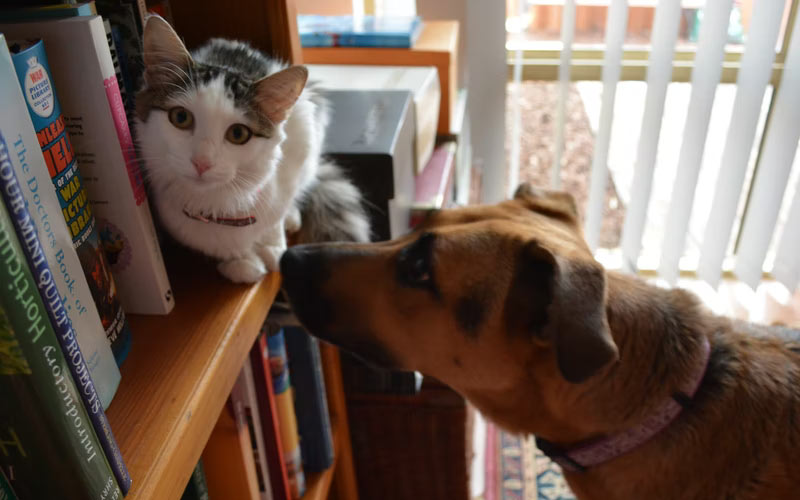
I am often asked how to make a new puppy (or dog) get along with the family cat or cats.
I always tell them, "This is a simple thing to do as long as you are willing to educate yourself on canine pack behavior and make a few changes in the way you live with your cats." I remind people that cats can instigate problems with dogs. This is not always a one-sided problem.
The average dog owner is completely unaware of how strong the genetic pack drive is in the domestic dog. Our dogs live their life by a set of genetic rules they are born with.
Over the years, I have introduced a number of dogs to our cats. We currently own 5 cats. Four inside-outside cats at our kennel, and one is our house cat. Our dogs have accepted and lived with my cats without problems.
I would have bet a lot of money that a couple of my past police dogs would never have accepted a cat. Had they not gone through our program, they would have killed our cats.
With that said, over the years, I have had a couple of dogs that I would never trust to be around my cats when I was not there. Had I made the mistake and allowed these dogs to be unsupervised with our cats, there is little doubt the dogs could have killed the cat. The solution to a successful dog-cat situation with these types of dogs, is to control the environment these animals were around one another and to ensure that the dog was ALWAYS under my control, either with a dog crate/ex-pen, a dog leash, or a remote collar.
The biggest part of a cat-dog problem is always the owners. Dog owners make huge mistakes if they are just bringing a pup or a dog into the home and let the animals sort things out for themselves. This is a formula for disaster.

The success of this program depends on...
- The ability of the new owners to be consistent in their training
- The efforts that the new owners are prepared to make to ensure success
- If the owners are preparing to establish pack structure and Obedience training
- The dogs
- The cats
The First Step
The first step in the process of acclimating a dog to your cat is to provide controlled and safe exposure. The dog must either be in a dog crate or on a leash in the house 100% for a long, long time. At the least, this period will be weeks, but many times, it can be months. There is no hurry. Those who rush the process are those owners who end up with problems.
I recommend the use of a dog crates. The use of a dog crate is the safest way to make sure you can control the environment. It allows you to focus on the cats while the dog is in the room.
In the beginning, cats are put in a separate room before the dog is brought into the house. I always put my new dogs on leash when I bring them into the house. This shows them that coming into the house is a controlled experience and not someplace where the dog can charge around and act crazy.
In other words, I ALWAYS control the animals and the environment I allow the animals to be in. That's how accidents are avoided. I don't leave things to chance. By having the dog on leash, I have control of him if the cat runs and he tries to chase.
People often ask, "When can the dog be off leash?" The answer is simple: when you can control the dog under distraction. If you can't call your dog to you when it is highly distracted by your cat, then the dog is not under your control, and it should either be on leash, in a dog crate, or wearing a remote collar.
This test can be made by putting the cat in the dog crate before the dog is brought into the house. The dog should be on leash. The owner can drop the leash and let the dog drag it. If the dog then gets out of control, the handler can simply grab the leash and take the dog back outside.
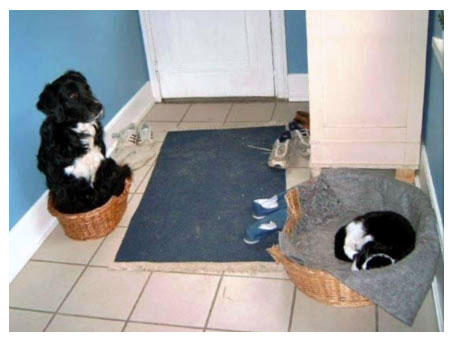
In The Crate
Once in the crate, the dog is expected to be calm and quiet. If the dog barks at the cats, they are verbally scolded. If they will not stop barking, we either cover the crate with a sheet, spray lemon water in the dog's face, or make them wear a bark collar. We normally don't use bark collars on puppies until they are 16 weeks old.
The dog is never allowed to be in the house and out of the crate unless it's on leash. It's never taken out of the crate (on leash) when the cat is in the room until it has gone ONE WEEK without barking at the cats.
This does not mean the dogs are locked in dog crates for weeks at a time. They can have free (on leash) time in the house but in the beginning, the cats are always put in a different closed room when the dog is out.
When I get a new adult dog, my first priority is to establish pack structure. I normally wait several weeks before I allow the dog to have on leash house time. This program is covered in detail in my DVD titled Establishing Pack Structure with the Family Dog. If you are a new dog owner, I highly recommend that you get this DVD and run your dog through this program.
Cat owners who acquire dogs have two processes going on at the same time. They should be establishing pack structure with the new dog at the same time they are teaching the dog that their cats are now part of the dog's family pack. When owners take their time there are seldom problems.
During the time that an adult dog spends in the crate, he can be acclimated to a muzzle. I like the wire basket muzzles we sell because they are less restrictive to the dog. Dogs accept these muzzles quicker than the plastic muzzles we sell. The downside is that they are a little more expensive.
For those people who do not want to spend the money on a wire muzzle, the plastic Jafco muzzles are inexpensive and work just fine. It is important to learn to put them on properly. When done incorrectly, the dog could possibly get them off. We always use marker training to put muzzles on.
Getting the dog used to the muzzle during these first weeks gives the dog something else to think about other than the cats in the house. After weeks of wearing it in the crate, it becomes second nature for the dog to have it on.
When the day comes to allow the dog to be loose in the rooms with the cats, it is important to do this while the dog is on leash. If that goes well, then have the dog in a muzzle.
Should the adult dog show the slightest sign of aggression towards the cat, it needs to get a correction. The severity of the correction will vary by the temperament of the dog. Some dogs simply need to be told NO, while other dogs require a level 10 prong collar correction.
The correction needs to be strong enough that the dog will remember it the next time it thinks about being aggressive to the cats. If you have been doing your training correctly, your dog will be looking at you as it's pack leader. Pack leaders determine when to use aggression, not lower-ranking members of the pack.
If a dog repeatedly ignores your warnings, you have not done a good enough job of establishing yourself as this dog's leader. Should this be the case, you need to go back to the pack structure training and work on that. You will also want to work on the dog's obedience training.
He will instinctively accept you as pack leader and your position that cats are not prey items to chase and kill.
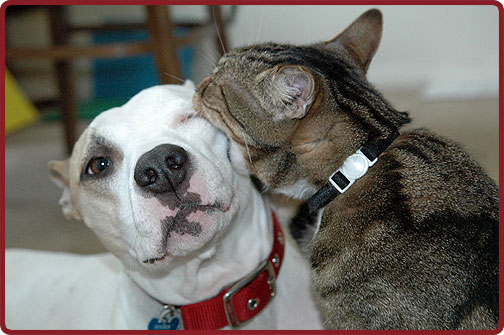
The Remote Collar - When the Muzzle Comes Off
At some point in time, the muzzle must come off.
This should only happen when you are comfortable with your dog's actions when the dog is on leash and the cats are around. You must have patience. For adult dogs and cats, this could take months. With time, they will settle into a lifestyle where both sides accept the fact that they now share the same territory.
I prefer to proof dogs around cats with a remote collar. In my opinion, using a remote collar is the safest, quickest way to teach a dog that chasing cats is not a fun thing to do. When it's done properly, this can have a lifelong effect on the dog.
I did a training DVD titled Remote Collar Training for the Pet Owner. In my opinion, everyone who owns a dog should learn how to train a dog with "LOW LEVEL" stimulation. This training is far more humane than a choke collar or a prong collar. It provides off-leash control of the dog that reinforces recalls and gives the owner the possibility of controlling off-leash unwanted behavior (like chasing cats).
At this stage of training, if a dog still chases the cat, I teach the dog that the cat is like touching a hot stove. When the dog chases, it gets a HIGH-LEVEL stimulation correction. (Not the low level we use in normal obedience training.) Usually, this only needs to be done once. After that, if the dog even looks at the cat, I say NO and give a low-level correction. The concept here is to stop unwanted behavior BEFORE the dog is in high drive. The higher the drive, the stronger the correction needs to be.
There are many brands of remote collars on the market. Most border on "a waste of good money". While we could sell any brand we wish, we use and recommend Dogtra Remote Collars in our home and kennel. This decision is based on over 30 years of using remote collars. You can contact us to ask what model we recommend for your dog.
Dogs and Cats Being Friends
The best of all worlds is when our dogs and cats become friends.
I need to say that there is a fine line between allowing the dog and cat to get to know one another and play together, and creating a safe environment.
Running in the house should never be allowed, even if it seems to be in play. When cats run, this can easily trigger prey drive in the dog. I had the experience of seeing a neighbor's dog kill a cat that the dog had lived with.
The cat ran across the front yard. This dog had a lot of prey drive. It chased the cat and killed it before anyone could even attempt to stop it. This taught me a valuable lesson: dogs may act one way in the home and a different way when they are outside.
The moral of the story is to err on the side of safety and be careful.
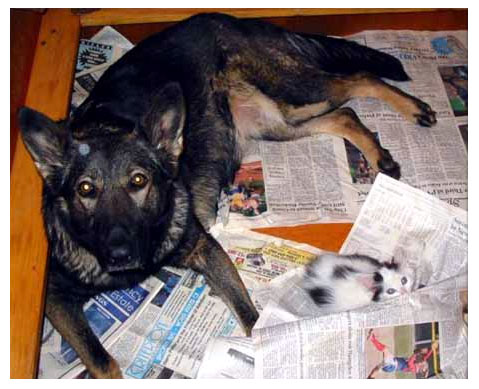
Cats and Dogs
Some cats accept dogs better than others.
One of our house cats (Garfield) came into the home as a kitten. The other (Fred) was an adult barn cat that was adopted. Garfield grew up with my old stud dog (Nick). He kind of adopted Nick as his best buddy. He looked at Nick as a heating pad. He would wait until Nick laid down and would go over and curl up on top of his tail and stomach.
For months, Nick would jump up and walk away in disgust. Over time they became friends with Nick eventually allowing Garfield to lay on top of him and curl up next to him whenever possible. He even allowed him to feed from the same food bowl while he was eating. This just amazed me because Nick was dog aggressive and would attack another male dog without hesitation.
On the other hand, Fred has never warmed to dogs. He learned to tolerate them on an individual basis, but he would always "hiss" if they come too close. He was no dummy, he knows who he can hiss at and who he must hide from. I think he used Garfield as a litmus test. He watched how the dogs reacted to Garfield and then based his response accordingly.
Then there are those cats who torment dogs. They know exactly what buttons to push to get a dog excited or mad enough to chase. Our office cat (Sting) knows exactly where the end of the dog's leash is when it's tethered to a desk. He will sit just outside of the area and stare at the dog. If he can get a dog's attention, he will jump straight up in the air and run away because he knows it drives the dogs nuts.
When we see Sting do this, we scold him. We either chase him away (as a good pack leader should), or we squirt him with a water bottle.
This speaks volumes to our dogs. It demonstrates leadership to the dog and don't for one minute kid yourself that the dog doesn't look at it like that.
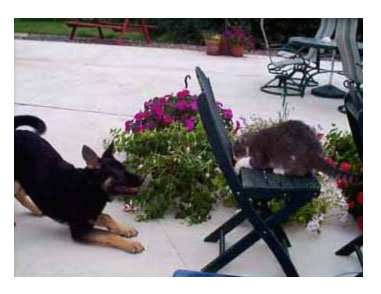
Cats and Puppies
Many people get puppies and bring them into the home where there is an existing cat.
Under these circumstances, it's important to realize that a cat with claws can take a pup's eye out in an instant. So if your cat has claws, you need to be more concerned for your 8-week-old pup than for your cat.
Follow the same steps with the dog crate. In this case, it teaches the cat that the dog is now a family member. If I have a pup with a lot of prey drive, I will get a puppy prong collar and let him drag a line in the house.
If he gets into trouble or tries to chase the cat, I will correct him. It does not take many corrections to teach the dog that "NO" means "NO." It's very important to show the pup a lot of love after these experiences. He must see that you do not hold any grudges and that you are still his best friend. So if you have to correct, then give ten times the cuddling after the correction.
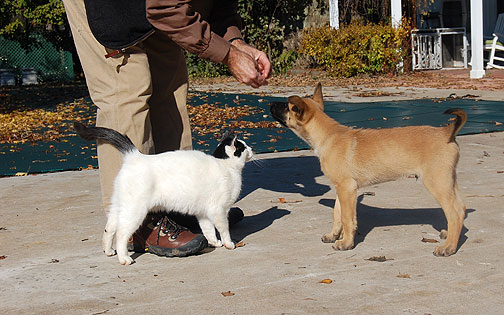
Conclusion
With a little bit of luck, you will be able to get your dog and cat to live together in peace. It's very important to remember to go slowly. No matter how quickly or badly you want it to happen, you have to allow these things to process at their own speed which can be a snail's pace over months. The best advice I can give is to err on the side of caution and don't take chances with your pet's lives.




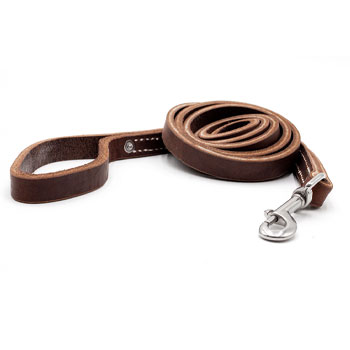
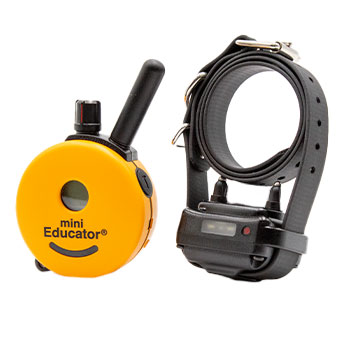
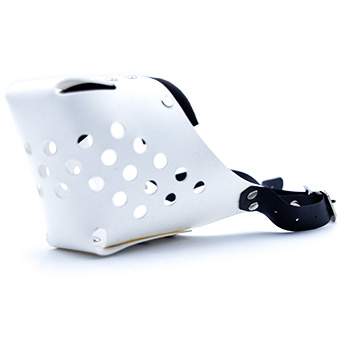
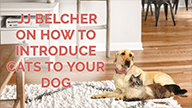


Ask Cindy.